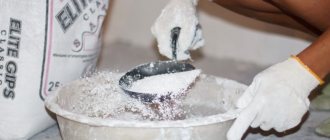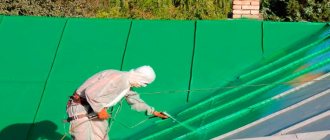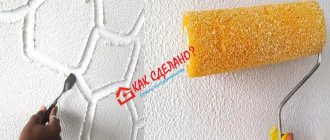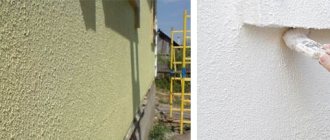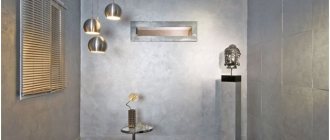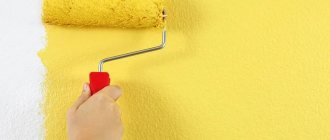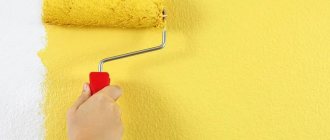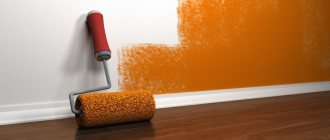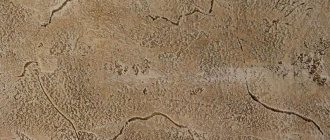Finishing the interior of a house or apartment is a very complex and labor-intensive process, in which water-based paint will help. It is important to approach repairs and decoration with special attention and care. The desire to save money, and sometimes just a craving for new experience and knowledge, forces ordinary people to do their own repairs.
For finishing the room, water-based emulsion is mainly used. This is a very high quality and affordable material. The paint can be easily applied to clean surfaces (concrete, wood, plaster and others); it is completely environmentally friendly.
Advantages of water-based paints
Paints for finishing coating of ceilings and walls of interiors, as well as facade work, have such a set of qualities that they are suitable for a huge variety of finishing works.
The composition of water-based paint includes substances that do not have strong odors and do not cause allergic reactions, both during coating and during operation.
This type of paint has a number of advantages:
- The paint contains no toxic substances, so it does not pose a threat to human health.
- Fast drying time of only 2-3 hours at average ambient temperatures.
- By adding the desired colors from ready-made commercially available paints, you can get almost any shade for painting walls.
- The ease of use of all-purpose trim paint allows it to be easily applied using regular painting tools.
- A huge selection of color solutions is easily achieved using water-based paints.
- Water- and polymer-based paint is not subject to fire.
- Low cost of paint, with economical consumption.
The only downside of water-based paint is that when applied to walls, it can crystallize if the temperature drops below +5 degrees.
Selecting paint based on the main component
Anyone who decides to make repairs with their own hands is faced with a choice of paints, which are presented on the market in a huge assortment. An inexperienced consumer can hardly figure out which water-based paint is better if products with the same name indicate differences in the composition of the components.
The main difference in all types of water-based paints is the basic composition of the aqueous polymer dispersion. The harmlessness of the paint is due to the absence of organic substances in its composition. Additives include stabilizers and emulsifiers.
Popular manufacturers
There is a wide variety of water-based compositions on the market. The best quality products are produced by European manufacturers such as Tikkurila, Dulux and Dufa. Products from well-known brands are expensive, but have excellent consumer characteristics and a proven reputation. Inexpensive paints from little-known companies are not always synonymous with low quality, but before purchasing, it is recommended to study reviews of such products on the Internet.
Qualities of acrylic paint
Universal in application, acrylic water-based paint is the most popular type among a number of analogues. It is made on the basis of polyacrylates and is perfect for painting any materials.
It can be used on concrete, plastered surfaces, wood, glass, stone and brickwork.
- Acrylic-based paints are completely waterproof, they can be washed and cleaned, as they are resistant to mechanical damage.
- They perfectly repel dust, as they are not capable of becoming electrified, and they mask small cracks on walls and ceilings.
- Despite the high density of surface coverage, they are very economical in consumption per 1 square meter.
Such paints can be used for painting any premises, as well as facades, since they do not fade or fade with prolonged exposure to sunlight.
What and how to paint? (Roller for water emulsion)
To apply paint use brushes, rollers or sprayers. Brushes are the best option for finishing small surfaces with many corners and convex details. A spray bottle is a convenient tool, but not everyone has one, and purchasing one just for painting is not very economical. Therefore, the best way to paint the surface with water-based emulsion is to use a roller, and the corners are painted with a brush.
Types of paint rollers
Foam rubber. Inexpensive in cost. The disadvantage is that they absorb too much dye, causing bubbles and unevenness to form on the coating, which then remain after drying.
Velor. To buy such a roller, you sometimes have to search, they are not sold everywhere. Velor rollers are characterized by low absorbency. This property has a positive effect on the quality of the paint; the composition applies smoothly and without flaws.
Fleecy. The most convenient option for painting. There are rollers on sale with different lengths of pile. The most expensive fleecy rollers are made from felt. Also a good choice are polyamide fiber rollers, a very practical option.
Latex based ceiling paint
If you want to enjoy the perfect look of the ceilings in your home, you may want to think about how to paint with water-based paint yourself so that the color turns out fresh and even. The best product for a snow-white ceiling is based on acrylic and latex substances.
- They lay down in an even, uniform layer, leaving no streaks from the painting tool.
- Latex gives paints special resistance to water and abrasion.
- The painted surface can be washed without disturbing its original appearance for up to 50 thousand cycles.
- The latex type of paint fits perfectly on metal, wood, concrete and wallpapered interior parts.
Removing old coating
Removing wallpaper
When gluing wallpaper before the start of European-quality renovations, they used CMC glue, Bustilat or a paste made from flour and starch. Moisten the wallpaper in small areas with a roller, brush or spray, wait about 5 minutes, and clean off with a sharp spatula. In this way, the entire room is cleaned, section by section.
Wallpaper that is glued with modern glue does not have such a strong bond with the surface, so it can be removed in whole sheets or the colored base is removed first, and then the backing.
Removing old paint
Wall panels that have been painted with oil or enamel paint are scraped off with a spatula. To speed up cleaning, the painted surface is “heated” with hot air using a hair dryer. Use the hairdryer carefully and keep your hands away from very hot air. Chemical solvents are also used to remove old paint. Follow safety precautions, wear safety glasses, a respirator, rubber gloves, and thoroughly ventilate the room.
Surfaces that have been whitewashed with lime or chalk. How to test chalk or lime? Wet a section of the wall using a brush. If there is no paint left on the brush, it's lime. The water and the brush turned white, it’s chalk. Whitewashing with lime, you don’t have to remove the whitewash. Whitewash with chalk, wash thoroughly with a brush, until plaster or concrete.
Wash panels that have been painted with water-based emulsion with clean water or a lint-free cloth.
Before applying a high-quality water-based emulsion, and then not repainting, it is advised to take full responsibility for repairing the surface.
Silicone paint for ceilings and walls
Thanks to the silicon resins included in the paint, such a high density of the covering layer is created that it easily hides minor defects and cracks up to 2 mm in depth.
- This type of finishing is excellent for painting walls and ceilings in rooms with high humidity, such as kitchens, bathrooms and shower rooms, baths and swimming pools.
- Even when vapors settle, surfaces of excellent quality coated with silicone paint can be quite easy to clean. In addition, it contains antiseptic substances that actively fight mold and mildew.
Silicate ceiling paint
This type of water-based paint is made on the basis of liquid glass. The basic component has many advantages, including: water resistance and breathability, high resistance to mechanical stress and durability.
It reliably protects wooden surfaces from fire and is completely environmentally neutral.
Many paints are marked with numbers that mean: 1 - for external types of work, 2 - for internal types of work.
Facade painting
Regarding the specifics of painting, several main points and nuances can be said. Before using the composition, you must carefully mix everything until smooth. If the instructions only indicate that the mixture is diluted with ordinary liquid, it is recommended to do this; this approach will allow the composition to lie evenly on the ceiling or wall. If there is a need to give your interior a brighter shade, this can be done easily, you just need to purchase a color scheme. The item will form a color palette, selecting the desired shade by mixing.
Dilute in a small container, then apply to cardboard and allow to dry. After this operation, it will be possible to determine whether the shade is suitable or not, which is due to the fact that the dried coating has a different appearance than the composition itself.
The coating itself will need to be made smooth and carefully prepared for painting. Before application, the wall or ceiling must be carefully puttied and primed with a special compound. When considering the issue of choosing a color, specific rules are provided. If the windows face south, purple, green, and blue will be considered an option. If you are facing north, it is best to consider warm colors, pink, raspberry, and orange stand out. When choosing shades, you cannot create problems; the colors are quite perfect. The future owner will be able to satisfy his wishes without any problems. The buyer is offered several material options to choose from, which can be combined with each other.
Please note: Velvet effect paint creates the illusion of walls covered with textiles. Conveys the tenderness of fleecy fabric and depth.
If you want to start work, you will need to clear the room of furniture. This will eliminate unpleasant factors when the structure becomes dirty with the composition and damage is caused to things. Prepare the necessary working tools in advance to avoid problems with application. When painting the ceiling, first apply several layers to level the surface; after this stage, you should start decorating.
Features of interior design using water-based paints
The rich possibilities of the color palette make water-based paint an excellent finishing material for implementing a variety of design ideas.
All the walls of the room can be painted in different colors, or visually expand the room with the help of multi-colored horizontal stripes on the walls.
- For a fashionable room decoration in 2-3 shades of gray, water-based paint is best suited, which creates gradations of the same color very well.
- Water-based paints are easy to create a colorful palette on their basis, and this makes it possible to use them to cover decorative panels made of plaster or wood.
